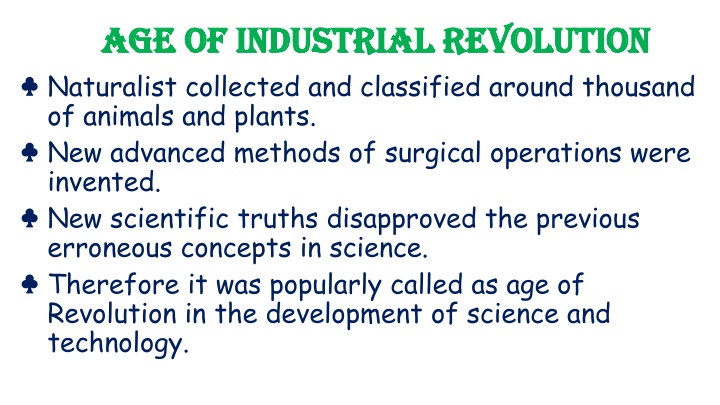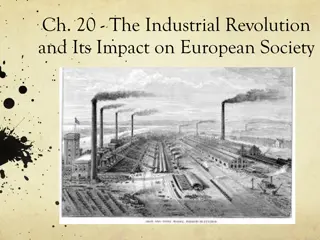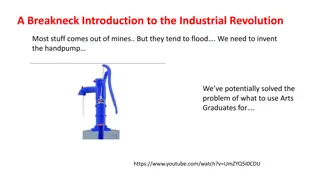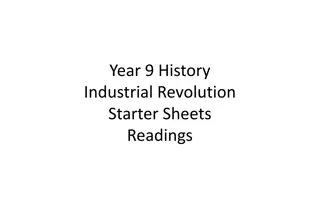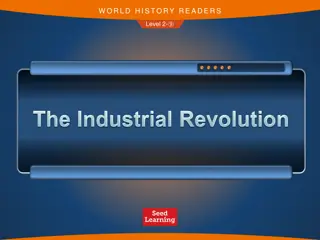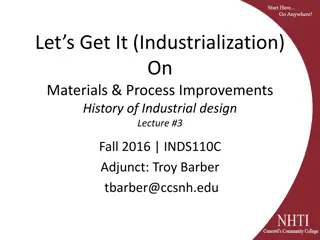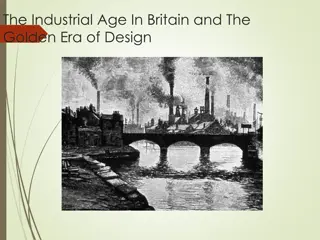Impact of the Industrial Revolution on Science and Technology
The Age of Industrial Revolution marked a significant shift in the development of science and technology. Naturalists collected and classified numerous animals and plants, while new surgical methods and scientific truths emerged. This era witnessed innovations such as James Watt's steam engine, advancements in the textile industry, and the introduction of machine-made products that revolutionized trade and commerce.
Download Presentation

Please find below an Image/Link to download the presentation.
The content on the website is provided AS IS for your information and personal use only. It may not be sold, licensed, or shared on other websites without obtaining consent from the author.If you encounter any issues during the download, it is possible that the publisher has removed the file from their server.
You are allowed to download the files provided on this website for personal or commercial use, subject to the condition that they are used lawfully. All files are the property of their respective owners.
The content on the website is provided AS IS for your information and personal use only. It may not be sold, licensed, or shared on other websites without obtaining consent from the author.
E N D
Presentation Transcript
Age of Industrial Revolution Age of Industrial Revolution Naturalist collected and classified around thousand of animals and plants. New advanced methods of surgical operations were invented. New scientific truths disapproved the previous erroneous concepts in science. Therefore it was popularly called as age of Revolution in the development of science and technology.
Why did the Industrial Revolution being in England? Availability of natural resources such as coal, iron and developed farmlands. steam engine and textile machines population growth from cottage system to factory system
James Watt's Steam Engine Scottish Inventor and Mechanical engineer it was called the Watt Steam Engine in 1775 the Watt Steam Engine was not the first steam engine. in 1679 Thomas Savery was the first person who invented the Steam engine for work in mines. in 1712 Thomas Newcomen (1663-1729) invented the first steam engine.
It widely used to pump water out of coal mines. he improved upon Newcomen Steam engine by using condenser, therefore it was known as the improved design of Newcomen engine.
Textile Industry The word calico is derived from Calicut a weaving centre on west coast of India. Calico the general term was used for all cotton cloths of all kinds import from the east. Calico introduced in England by EEIC. Lancashire in England famous centre of textiles In Latin textile means a woven fabric 18th Century had tremendous progress in textile industry
Outbreak of Industrial Revolution in England brought a radical change in the spinning and weaving technology. Man-made textiles were replaced by machine-made products Discovery of new trade and sea routes which promoted trade and commerce.
John Kays Flying Shuttle (1733) In 1733 John Kays (1704-64) invented flying shuttle. It was the first great invention for increasing the productions of textiles. John Kays basically clock maker. It used for quick weaving to be produce faster and large quantity.
James Hargreaves(1702-1778) Spinning Jenny (1764) he named after the berth of his daughter Jenny. it used 8 spindles instead of 1. A single wheel on the spinning jenny controlled 8 spindles which create 8 threads. later on, models had up to 120 spindles
Edmund Cartwright Power Loom (1785 ) For weaving as well as spinning.
Eli Whitney's Cotton Gin (1793) Eli Whitney's Cotton Gin invented in 1793. it separated cotton from seeds it removed the seeds from the cotton quickly and efficiently.
